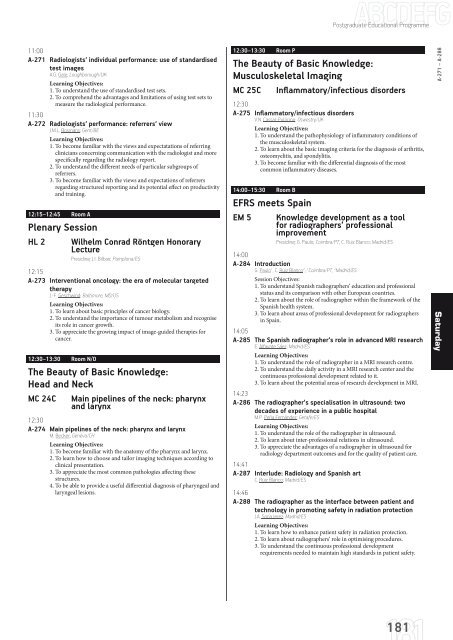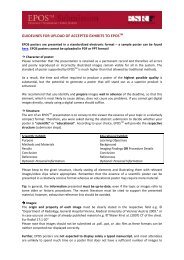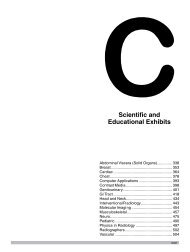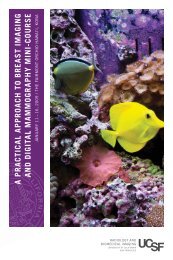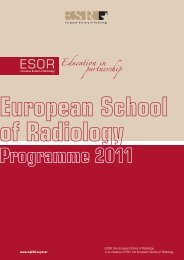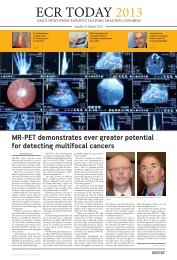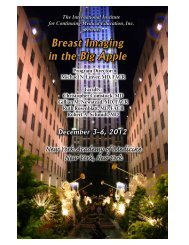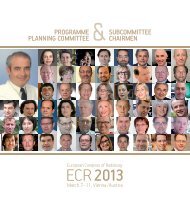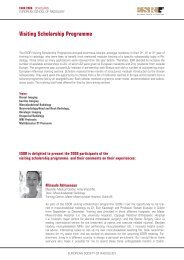ECR 2013 â Final Programme - myESR.org
ECR 2013 â Final Programme - myESR.org
ECR 2013 â Final Programme - myESR.org
- No tags were found...
You also want an ePaper? Increase the reach of your titles
YUMPU automatically turns print PDFs into web optimized ePapers that Google loves.
Postgraduate Educational <strong>Programme</strong>11:00A-271 Radiologists‘ individual performance: use of standardisedtest imagesA.G. Gale; Loughborough/UKLearning Objectives:1. To understand the use of standardised test sets.2. To comprehend the advantages and limitations of using test sets tomeasure the radiological performance.11:30A-272 Radiologists‘ performance: referrers‘ viewJ.M.L. Bosmans; Gent/BELearning Objectives:1. To become familiar with the views and expectatations of referringclinicians concerning communication with the radiologist and morespecifically regarding the radiology report.2. To understand the different needs of particular subgroups ofreferrers.3. To become familiar with the views and expectations of referrersregarding structured reporting and its potential effect on productivityand training.12:15–12:45 Room APlenary SessionHL 2 Wilhelm Conrad Röntgen HonoraryLecturePresiding: J.I. Bilbao; Pamplona/ES12:15A-273 Interventional oncology: the era of molecular targetedtherapyJ.-F. Geschwind; Baltimore, MD/USLearning Objectives:1. To learn about basic principles of cancer biology.2. To understand the importance of tumour metabolism and recogniseits role in cancer growth.3. To appreciate the growing impact of image-guided therapies forcancer.12:30–13:30 Room N/OThe Beauty of Basic Knowledge:Head and NeckMC 24C Main pipelines of the neck: pharynxand larynx12:30A-274 Main pipelines of the neck: pharynx and larynxM. Becker; Geneva/CHLearning Objectives:1. To become familiar with the anatomy of the pharynx and larynx.2. To learn how to choose and tailor imaging techniques according toclinical presentation.3. To appreciate the most common pathologies affecting thesestructures.4. To be able to provide a useful differential diagnosis of pharyngeal andlaryngeal lesions.12:30–13:30 Room PThe Beauty of Basic Knowledge:Musculoskeletal ImagingMC 25C Inflammatory/infectious disorders12:30A-275 Inflammatory/infectious disordersV.N. Cassar-Pullicino; Oswestry/UKLearning Objectives:1. To understand the pathophysiology of inflammatory conditions ofthe musculoskeletal system.2. To learn about the basic imaging criteria for the diagnosis of arthritis,osteomyelitis, and spondylitis.3. To become familiar with the differential diagnosis of the mostcommon inflammatory diseases.14:00–15:30 Room BEFRS meets SpainEM 5 Knowledge development as a toolfor radiographers’ professionalimprovementPresiding: G. Paulo; Coimbra/PT, C. Ruiz Blanco; Madrid/ES14:00A-284 IntroductionG. Paulo 1 , C. Ruiz Blanco 2 ; 1 Coimbra/PT, 2 Madrid/ESSession Objectives:1. To understand Spanish radiographers‘ education and professionalstatus and its comparison with other European countries.2. To learn about the role of radiographer within the framework of theSpanish health system.3. To learn about areas of professional development for radiographersin Spain.14:05A-285 The Spanish radiographer‘s role in advanced MRI researchE. Alfayate Sáez; Madrid/ESLearning Objectives:1. To understand the role of radiographer in a MRI research centre.2. To understand the daily activity in a MRI research center and thecontinuous professional development related to it.3. To learn about the potential areas of research development in MRI.14:23A-286 The radiographer‘s specialisation in ultrasound: twodecades of experience in a public hospitalM.P. Peña Fernández; Getafe/ESLearning Objectives:1. To understand the role of the radiographer in ultrasound.2. To learn about inter-professional relations in ultrasound.3. To appreciate the advantages of a radiographer in ultrasound forradiology department outcomes and for the quality of patient care.14:41A-287 Interlude: Radiology and Spanish artC. Ruiz Blanco; Madrid/ES14:46A-288 The radiographer as the interface between patient andtechnology in promoting safety in radiation protectionJ.A. Soria Jerez; Madrid/ESLearning Objectives:1. To learn how to enhance patient safety in radiation protection.2. To learn about radiographers‘ role in optimising procedures.3. To understand the continuous professional developmentrequirements needed to maintain high standards in patient safety.A-271 – A-288Saturday181


